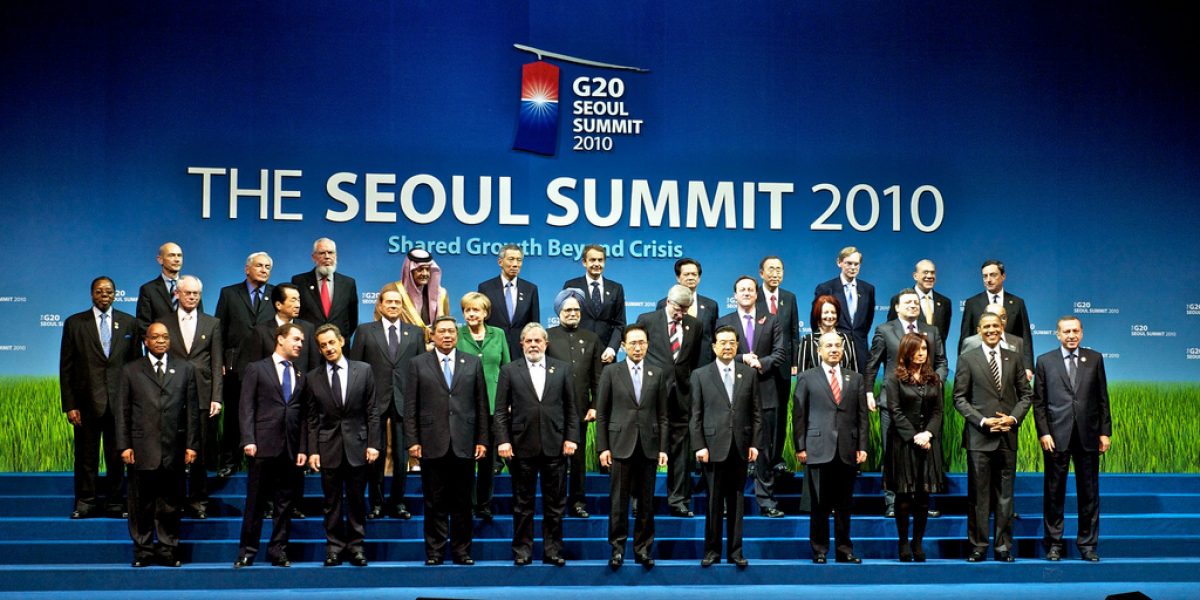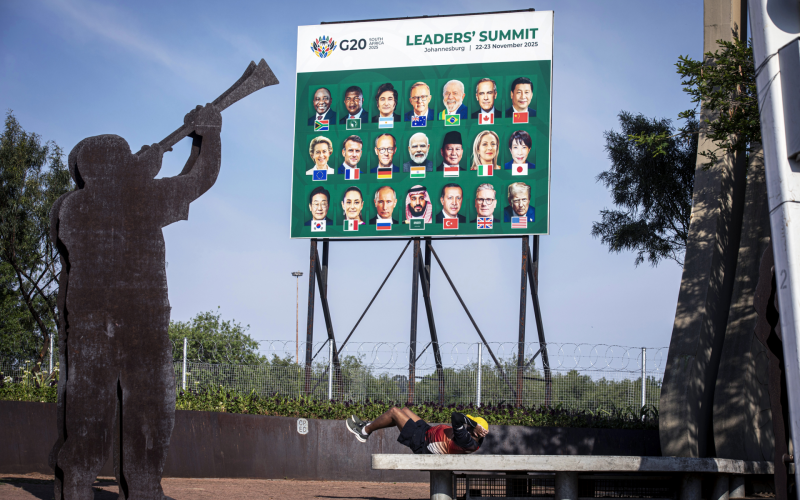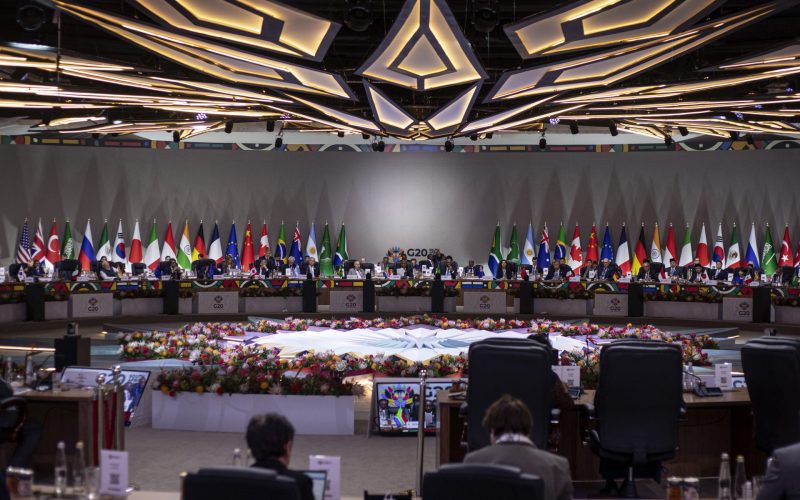Its outcomes were predictable. On the negative side of the balance sheet there was no substantive agreement on resolving global imbalances thus presaging continuation of the ‘currency wars’; and no substantive agreement on bringing the marathon Doha round of WTO negotiations to a successful close.
Therefore trade protection is likely to escalate, with uncertain consequences for the multilateral trading system on the one hand but increasing recourse to regionalism on the other. On the positive side of the balance sheet reform of the IMF board through reallocating two European seats to ‘dynamic emerging markets’ and ‘under-represented countries’ was endorsed with the details being left to complex political horse-trading to unfold next year. Basle 3 financial regulatory proposals were also endorsed, and a putative ‘Seoul consensus on development’ was announced. The latter is intended to replace the so-called ‘Washington consensus’; whilst its details are sketchy to outsiders its optics are good since it punts the G-20’s flagging legitimacy credentials in the developing world – to some extent.My purpose is not to reflect on these substantive issues – which SAIIA intends to do in the coming months – but rather to consider how the South African print media engaged with this summit in its effort to inform the public. Print media coverage is important in informing the educated public about what takes place in these summits and drawing out the policy implications for a new member such as South Africa.
For this interested observer, the Seoul summit marked something of a watershed in the South African print media’s coverage of G-20 summits. In previous reportage on this issue, which I have compiled for a CIGI-Brookings joint initiative (available here), South African generated articles – as opposed to those ‘picked up on the wires’ – were notably absent from the national print media scene. This time around substantial domestically-generated media coverage was evident in the four publications I monitored: Business Day; Business Report; Engineering News; and the Mail and Guardian (a weekly paper).
Much of the coverage in the build up to the summit focused on the ‘currency wars’, a very popular topic with the media globally and domestically. In the final days before the summit Business Report provided some insight into South Africa’s thinking regarding IMF reform in particular. The significance of this development, for me, lay in the fact that that publication is now part of a ‘P20’ grouping of print media publications. This suggests, perhaps, a new seriousness – at least for this publication – with regard to reporting on G-20 summits, a welcome development indeed.
Particular attention was paid to Finance Minister Gordhan’s remarks concerning the US Federal Reserve’s quantitative easing or ‘QE2’ policy; remarks which received international media attention from amongst others the Financial Times. Later in the week his remarks were qualified, and this qualification (he broadened his criticism of competitive devaluations beyond the US without naming specific countries) also received some domestic coverage. However, in the few days before the summit Business Report in particular began to report on other aspects of the summit agenda, notably reform of the IMF and the Finance Minister’s stated goal of securing one board seat for South Africa and an African constituency. Business Report seemed to have some channel to the Finance Minister, probably by virtue of its ‘P20’ membership, that other publications either didn’t or chose not to exploit.It is difficult to say whether this relative coverage either threatened or enhanced the G-20’s viability in the public’s eye. There is much skepticism regarding the potential for the G-20 to resolve the imbalances problem, as captured in the title of a Business Day editorial printed as the summit got underway: ‘Little the G-20 can do to shift the trend’. Many of the independent commentators quoted (including this one) were skeptical whether anything would be achieved on this front. However, whilst this issue dominated the headlines prior to the summit, Business Report was offering broader insights into IMF reform and the ‘Seoul Consensus’ on development as the summit was drawing to a close. And Engineering News reported on a G-20 discussion which also drew minimal attention from Business Day: the potential for the G-20 to establish ‘global investment rules’ (which for the record President Zuma publicly opposed).
Concerning the substance of the ‘currency wars’ reportage, little attention was paid to the G-20 “framework for strong, sustainable and balanced growth” as a means of capturing the medium term trajectories of G-20 countries and using them to achieve “collective consistency” over time through a “mutual assessment process” underpinned by the IMF and involving G-20 peer review to gradually reduce global imbalances within a cooperative effort. Rather, the focus for the most part was on the ‘currency wars’; reactions to US ‘QE2’; the potential for trade wars to break out which exercised the Mail and Guardian especially; and the broader differences amongst G-20 states on these matters.
To crudely summarise, one had the impression that a prize fight was taking place and no-one was too concerned about the rules governing it although there was some attention paid to the girls carrying the signboards!
In contrast to previous summits President Zuma’s interventions did receive some press coverage at home, particularly in Business Report but also in Engineering News. The quotations were generally offered in neutral tones, and the substance of his quoted remarks seemed sensible. In short to judge from this coverage he seems to have played his cards reasonably well and to have been visible. Furthermore, Finance Minister Gordhan also received substantial coverage locally for his stances on the currency issue and IMF reform; again he was favourably quoted which seems to have added to his growing reputation at home, and perhaps abroad.
Not much attention was paid to the summit host South Korea, as a rising industrial power aspiring to a leadership role in the world. Two articles in Business Report, the first, prior to the summit, highlighted precisely these dynamics and quoted South Korean President Lee speaking approvingly of his relationship with President Zuma; the second went into some detail on the development working group (which South Africa co-chairs with South Korea) and the importance of this group’s work to the future of the G-20. The Mail and Guardian also carried an article by veteran critic of the Washington consensus and Korean national, Professor Ha-Joon Chang, lauding the virtues of ‘the Korean model’ of development but lamenting that the ‘Seoul consensus’ did not go far enough in reflecting what he regards as its inner core: interventionist and protectionist industrial policies.
Interestingly, if Professor Chang had his way the world would arguably be much worse off with each country pursuing its own narrow perceived national self-interest – protecting industries; maintaining undervalued currencies; and pursuing all of this through authoritarian growth models in which labour is repressed and dissent curtailed.
In this light I hope that the G-20 can get its act together concerning macroeconomic imbalances, and soon. But I won’t be holding my breath.








